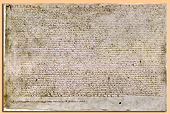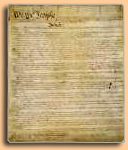|

An extraordinary document - The British Bill of Rights
Image courtesy of the UK Parliamentary Archives
British Bill of Rights 1689
... the Parliamentray Archives further explain that the Bill of Rights 1689 is an
iron gall ink manuscript on parchment.
How about that!
Iron gall is a type of ink that was historically made from tannin extracted from oak galls and iron salts,
typically ferrous sulfate. It was commonly used from the medieval period through the 19th century for
writing and drawing due to its deep black color and permanence. The ink would darken over time as the iron
oxidized, and it was favored by many famous writers and artists.
|
|
But "What is tannin?", I hear you whisper.
Tannin is a type of polyphenolic compound found in various plants, particularly in the bark,
leaves, and fruit.
It has astringent properties, meaning it can cause tissues to contract and dry out.
|
Tannins are responsible for the bitterness in many fruits and the astringency in beverages like tea and wine.
It's used in the tanning of leather, in the production of inks (like iron gall ink), and for its antioxidant properties.
Tannins can also bind with proteins and other macromolecules, which is why they're often used in food preservation and
traditional medicine.
Back to what was written whith this ink:
The official name of the British Bill
of Rights is:
An Act Declaring the Rights and Liberties of the
Subject and Settling the Succession of the Crown.
Today's UK constitution has not been codified, which means it has not been written down in a single, comprehensive document.
This is a key characteristic that distinguishes the UK from many other countries.
Instead of a single document, the UK constitution is derived from Acts of Parliament, judicial decisions, etc. One
example of an important constitutional statute is the 1689 Bill of Rights.
This document was extraordinary for establishing key principles of constitutional
monarchy and parliamentary democracy that continue to shape governance in the UK and many other countries to this day.
Brief Introduction courtesy of the House of Commons
(The House of Commons is one of the two houses of the Parliament of the United Kingdom, the other being the House of Lords.)
[The 1689 Bill of Rights] is one of the four great historic documents which regulate the relations between the
Crown and the people, the others being:
the Magna Carta (as confirmed by Edward I, 1297),
the Petition of Right (1627)
and the Act of Settlement (1700).
To this list of fundamental constitutional documents should be added the recent Human Rights Act 1998.
The Bill of Rights [...] intentions were: to depose James II for misgovernment; to determine the succession to the
Throne; to curb future arbitrary behaviour of the monarch; and to guarantee parliament’s powers vis a vis the Crown,
thereby establishing a constitutional monarchy.
What's in the 1689 Bill of Rights?
- Parliamentary supremacy was affirmed, making Parliament the supreme source of law-making over the monarch and courts.
Rulers were now prevented from suspending laws or levying taxes without parliamentary consent. Raising or keeping a standing
army within the kingdom during peacetime without Parliament's consent was now illegal.
- Members of Parliament were granted the right to free speech and debate within Parliament without fear of prosecution
or questioning outside of Parliament.
- Free elections and regular meetings of Parliament were guaranteed.
- English citizens were granted certain individual rights and liberties, for example the bill prohibited excessive bail,
excessive fines, and cruel and unusual punishments. Citizens also gained the right to petition the king without fear of
prosecution or punishment.
- Protestants were allowed to bear arms for self-defense. The Militia Act of 1662 had previously excluded those who were not
in communion with the Church of England from serving in the militia. This barred all Catholics, but also Protestant
dissenters and nonconformists from bearing arms.
- Catholics were banned from ever becoming monarchs again. And therefore James II had to pass on his ruling powers to his
eldest daughter
 Mary II
and her husband
Mary II
and her husband
 William III.
The rightful heirs to the throne are: First Mary's
children, then Princess Anne and then her children.
William III.
The rightful heirs to the throne are: First Mary's
children, then Princess Anne and then her children.
Why Was the Bill Written?
The Bill of Rights arose from a pivotal moment in English history known as the
 Glorious Revolution of 1688.
Glorious Revolution of 1688.
The English wanted to put on record the outcome of the long quarrel between the monarchs on one side and the
English people and the Parliament on the other side.
A crucial shift in the balance of power between the monarchy and Parliament took place, and the Bill of Rights made it official.
Impact of the 1689 Bill of Rights
The Bill made Parliament the ruling power of England, but had far-reaching effects beyond England. It
served as an important model for later rights documents, including the United States Bill of Rights and the UN Declaration of Human Rights,
as well as the European Convention on Human Rights.
You can
 read the full text of the British Bill of Rights here (Provided by The British National Archives.)
read the full text of the British Bill of Rights here (Provided by The British National Archives.)
Go here for the
 Act of Settlement (1701)
Act of Settlement (1701)
Go here if you're looking for the
 American Bill of Rights.
American Bill of Rights.
Now back to serious iron gall ink talk:
Many famous historic documents were written with iron gall ink, including the Magna Carta (1215), the
U.S. Declaration of Independence (1776), the Constitution of the United States (1787) etc.
I hear you gasping, and you would be right to gasp, yess, iron gall ink was widely used for scientific,
academic, and otherwise important writings from the Middle Ages through the 19th century. It was appreciated
for its rich blue-black color and its ability to penetrate paper fibers, making it difficult to erase or alter documents.
And now the link you've been waiting for:
 How to make iron gall ink
How to make iron gall ink
I feel like this article slightly derailed the second we ran into the amazing world of iron gall ink...
By the way, ever wondered about parchment?
More History
|
| |
Can't hear enough about iron gall ink?
Perfectly understandable!
Of course, and maybe unfortunately, there is no gallbladder involved. Gall in this context refers
to an abnormal outgrowth of plant tissue usually due to insect or mite parasites or fungi.
In particular, we're looking at oak galls here, which are growths that form on oak trees
when certain insects lay their eggs on the tree's buds or leaves. The tree responds by
producing a mass of tissue, creating a gall.
These galls are rich in tannins, which are essential for making iron gall ink.
When making the ink, the tannin extracted from the oak galls is combined with iron salts.
Which leads us to the question:
What is ferrous sulfate?
Ferrous sulfate is an iron salt with the chemical formula FeSO₄. It typically appears as a
blue-green crystalline solid and is commonly used in various applications, including:
Agriculture:
As a soil supplement to provide iron for plants, helping to prevent iron chlorosis.
Water Treatment:
To remove impurities from water and as a flocculating agent.
Manufacturing:
In the production of pigments and as a reducing agent in chemical reactions.
Medicine:
As an iron supplement to treat or prevent iron deficiency anemia.
In the context of iron gall ink, ferrous sulfate serves as one of the key ingredients
that reacts with tannins to produce the ink's dark color.
Remains only to understand:
What's a polyphenol?
Polyphenols, not to be confused with Polyphemos, the Cyclops from the Odyssey, are good
for you, and might even be very good for you.
Polyphenolic compounds are a group of naturally occurring substances found in plants,
characterized by the presence of multiple phenol units in their chemical structure.
These compounds play a significant role in plant defense mechanisms and have been studied
for their potential health benefits, including anti-inflammatory, anti-cancer, and cardiovascular
protective effects.
In other words: eat berries, grapes, apples, pears, cherries, plums, citrus fruits, and pomegranates.
They're all high in polyphenols.
Frequently Viewed
Documents

Magna Carta 1215

U.S. Constitution 1787

Famous Speeches in History
Browse the speech archive:
 Speeches by Topic A-Z
Speeches by Topic A-Z
 Speeches by Speaker A-Z
Speeches by Speaker A-Z
 Speeches in Chronological
Order
Speeches in Chronological
Order
 Speeches Given by Women
Speeches Given by Women
 Speeches Given by African-Americans
Speeches Given by African-Americans
 Speeches Given by U.S. Presidents
Speeches Given by U.S. Presidents
Attila the Hun
More about the greatest of all Barbarian rulers:
 Attila short biography
Attila short biography
 Map of Attila's empire
Map of Attila's empire
 Battle of the Catalaunian
Plains
Battle of the Catalaunian
Plains
 Who were the Huns?
Who were the Huns?
Greco-Persian Wars
Also called the
Persian Wars, the Greco-Persian Wars were
fought for almost half a century from 492 to
449 BC. Greece won against enormous odds. Here
is more:
 Battle of Marathon
Battle of Marathon
 Battle of Thermopylae
Battle of Thermopylae
 Battle of Salamis
Battle of Salamis
 Battle of Plataea
Battle of Plataea

Meanwhile in Scotland...
The Claim of Right Act, enacted in April 1689, was a significant
constitutional document passed by the "Estates of the Kingdom of Scotland".
It asserted that James VII (also known as James II of England) had forfeited the Scottish throne by
violating the constitution of Scotland, and
declared that the Scottish monarchy was a legal limited monarchy rather than an arbitrary despotic power.
James had fled England in December 1688, and escaped to France. At the time the Scottish Claim of Right Act was enacted,
James VII was
in Ireland, where with the help of the French, he tried to rally support in order to take back power.
James' resistance cumulated in the
 Battle of the Boyne, fought on July 11, 1690
(New Style, or July 1st Old Style).
Approx. 60,000 soldiers engaged, but James had to retreat and fled again to France, this time for good.
Battle of the Boyne, fought on July 11, 1690
(New Style, or July 1st Old Style).
Approx. 60,000 soldiers engaged, but James had to retreat and fled again to France, this time for good.
Here you can read the full
 Claim of Right Act
Claim of Right Act
|
|